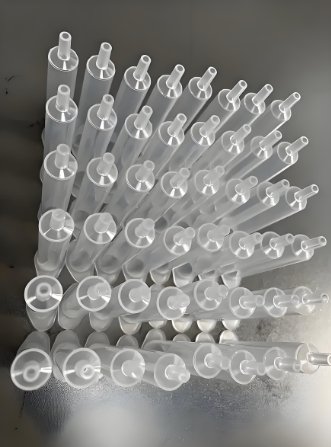
Medical tubing and connectors are essential in healthcare. They transport fluids, deliver oxygen, and support medical devices. Medical injection molding produces these parts with high precision. Mold makers design molds for durability, flexibility, and sterility.
Importance of Medical Tubing and Connectors
1. Essential for Patient Care
Medical tubing delivers medication, fluids, and gases. Connectors ensure a secure, leak-free fit.
2. Prevents Contamination
Sterile tubing and connectors protect patients from infections.
3. Supports Life-Saving Equipment
They are used in ventilators, IV lines, dialysis machines, and more.
4. Ensures Consistent Performance
Medical-grade plastics maintain strength, flexibility, and chemical resistance.
5. Meets Strict Medical Standards
Each part must comply with FDA and ISO requirements.
Common Applications of Medical Tubing and Connectors
1. Intravenous (IV) Tubing
IV tubing delivers fluids, medications, and nutrients. It must be flexible and kink-resistant.
2. Catheter Tubing
Catheters help drain fluids and assist in surgeries. They must be soft and biocompatible.
3. Respiratory Tubing
Oxygen tubes and ventilator hoses deliver air to patients. They require precision to ensure airflow.
4. Dialysis Tubing
Dialysis machines use tubing to filter blood. It must be durable and chemical-resistant.
5. Feeding Tubes
These tubes provide nutrition to patients who cannot eat normally. They must be safe for prolonged use.
6. Surgical Suction Tubing
Used to remove fluids during surgery. It must be strong and flexible.
7. Luer Lock and Quick Connectors
These connectors ensure secure attachment between tubes and devices.
8. Blood Collection Tubes and Ports
Used in diagnostic testing and blood transfusions. They require airtight seals.
Materials Used in Medical Injection Molding for Tubing and Connectors
1. Polyvinyl Chloride (PVC)
PVC is flexible, durable, and resistant to chemicals. It is used in IV and respiratory tubing.
2. Silicone
Silicone is soft, biocompatible, and heat-resistant. It is used in catheters and surgical tubing.
3. Polyurethane (PU)
PU is flexible and strong. It is used in catheter and wound drainage tubes.
4. Polyethylene (PE)
PE is lightweight and chemical-resistant. It is used in feeding tubes and dialysis tubing.
5. Thermoplastic Elastomers (TPEs)
TPEs provide flexibility and durability. They are used in medical tubing seals and gaskets.
6. Polycarbonate (PC)
PC is clear and impact-resistant. It is used in rigid connectors and blood collection ports.
How Mold Makers Ensure High-Quality Medical Tubing and Connectors
1. Precision Mold Design
Mold makers create detailed designs to ensure uniform wall thickness and flexibility.
2. Advanced Material Selection
Choosing the right material is crucial for performance and safety.
3. Cleanroom Manufacturing
Production must take place in a sterile environment to prevent contamination.
4. High-Quality Molding Techniques
Injection molding ensures smooth, defect-free surfaces for tubing and connectors.
5. Rigorous Quality Control
Products undergo strict testing for strength, flexibility, and sterility.
Advantages of Medical Injection Molding for Tubing and Connectors
1. High Precision and Consistency
Injection molding ensures each part meets exact specifications.
2. Cost-Effective Mass Production
Large quantities can be produced at low costs.
3. Sterility and Biocompatibility
Medical-grade plastics meet strict hygiene standards.
4. Customization for Specific Applications
Different shapes, sizes, and materials can be tailored for medical needs.
5. Strong and Flexible Materials
Injection-molded parts maintain durability while remaining lightweight.
Challenges in Medical Injection Molding for Tubing and Connectors
1. Meeting Regulatory Standards
Each product must comply with FDA and ISO medical guidelines.
2. Preventing Contamination
Sterile manufacturing conditions are critical.
3. Maintaining Flexibility and Strength
The right material balance is needed to ensure tubing does not crack or kink.
4. Achieving Secure Connections
Connectors must fit tightly to prevent leaks or detachment.
5. Managing Production Costs
High-quality materials and cleanroom production can be expensive.
Innovations in Medical Injection Molding for Tubing and Connectors
1. Advanced Micro-Molding
Smaller, more precise parts improve performance in medical devices.
2. Biodegradable Plastics
Eco-friendly materials reduce medical waste.
3. Multi-Layer Tubing
Different materials combined in one tube enhance strength and flexibility.
4. Smart Tubing Technology
Embedded sensors can monitor flow and pressure in medical tubes.
5. High-Speed Automation
Robotic systems improve efficiency and reduce human errors.
Future Trends in Medical Injection Molding for Tubing and Connectors
1. More Biocompatible Materials
New materials will enhance safety and comfort.
2. Greater Customization for Patient Needs
Injection molding will allow more specialized tubing and connectors.
3. Faster and More Efficient Production
Automation and AI will improve manufacturing speed and accuracy.
4. Stricter Quality and Safety Standards
Regulations will continue to evolve for better patient safety.
Medical injection molding plays a vital role in producing medical tubing and connectors. These components are essential for patient care. Mold makers ensure precision, safety, and sterility in every part. As technology advances, medical tubing and connectors will become even more efficient and reliable.
